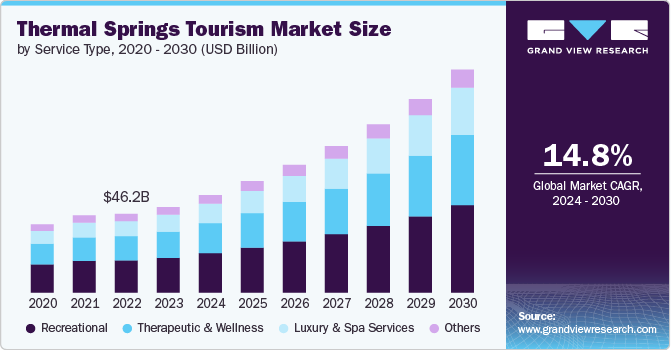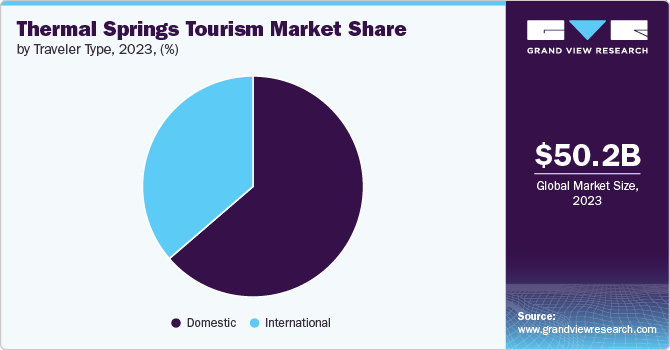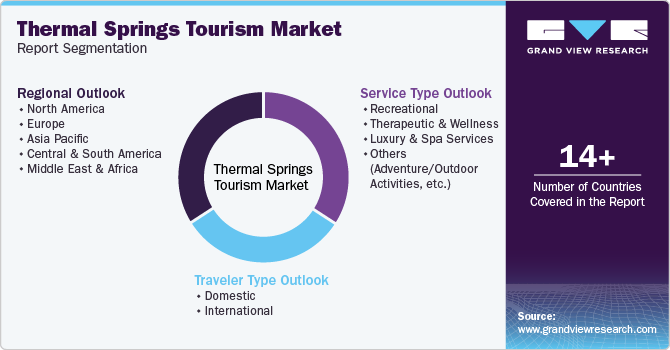- Home
- »
- Homecare & Decor
- »
-
Thermal Springs Tourism Market Size & Share Report, 2030GVR Report cover
![Thermal Springs Tourism Market Size, Share & Trends Report]()
Thermal Springs Tourism Market Size, Share & Trends Analysis Report By Service Type (Recreational, Therapeutic & Wellness, Luxury & Spa Services), By Traveler Type, By Region, And Segment Forecasts, 2024 - 2030
- Report ID: GVR-4-68040-470-2
- Number of Report Pages: 100
- Format: PDF, Horizon Databook
- Historical Range: 2018 - 2023
- Forecast Period: 2024 - 2030
- Industry: Consumer Goods
Thermal Springs Tourism Market Trends
The global thermal springs tourism market size was estimated at USD 50.19 billion in 2023 and is projected to grow at a CAGR of 14.8% from 2024 to 2030. The market has witnessed significant growth in recent years, driven by a confluence of factors that encompass wellness trends, increasing consumer awareness of health benefits, and a growing preference for natural remedies. Thermal springs, known for their therapeutic properties, have become increasingly appealing to travelers seeking relaxation and holistic wellness experiences. This surge in demand aligns with a broader global trend emphasizing wellness travel, where individuals prioritize mental and physical health, often opting for destinations that offer rejuvenating experiences.

The expansion of the thermal springs tourism sector can also be attributed to enhanced accessibility and infrastructure improvements in many regions. Destinations renowned for their thermal springs, such as Hungary, Japan, and Iceland, have invested in developing modern facilities and services that cater to a diverse clientele. These investments not only enhance the visitor experience but also attract new market segments, including families and adventure seekers. As travelers seek unique and enriching experiences, thermal springs have emerged as a desirable option, offering not just relaxation but also opportunities for exploration and adventure in natural settings.
According to statistics from the Global Wellness Institute, the global count of thermal and mineral springs establishments reached 31,290 in 2022. This figure is projected to experience significant growth in the forthcoming years. This anticipated expansion is expected to substantially contribute to the overall growth of the market, driven by increasing consumer interest in wellness and holistic health experiences.
The rise in thermal and mineral springs establishments indicates a burgeoning recognition of the therapeutic benefits of these natural resources. As more destinations develop facilities catering to health-conscious travelers, the market is likely to attract a diverse clientele seeking relaxation, rejuvenation, and wellness. Furthermore, the proliferation of such establishments enhances competition, prompting existing facilities to innovate and improve their service offerings, thereby elevating the overall customer experience.
Consumer trends reveal a growing inclination toward eco-friendly and sustainable tourism practices. Travelers are increasingly aware of the environmental impact of their choices and are opting for destinations that promote sustainable practices. Many thermal springs facilities are capitalizing on this trend by implementing eco-conscious initiatives, such as using renewable energy sources, promoting local products, and engaging in conservation efforts. This commitment to sustainability resonates with consumers who prioritize responsible travel, further driving interest in thermal springs as a travel destination.
Additionally, the rise of digital marketing and social media has significantly influenced consumer behavior in the thermal springs tourism market. Platforms like Instagram and TikTok have enabled travelers to share their experiences, showcasing the picturesque landscapes and unique offerings of thermal springs. This visual marketing not only elevates the profile of these destinations but also fosters a sense of community among like-minded travelers, creating a buzz that attracts a younger demographic. As millennials and Generation Z increasingly prioritize wellness and unique experiences, thermal springs tourism is positioned to capture their attention effectively.
The demand for thermal and mineral spring bathing experiences is rising among consumers who seek a deeper connection with nature, a desire to engage in cultural traditions, and prefer alternative health modalities focused on healing, rehabilitation, and prevention. In response to these evolving trends, both private investors and government entities are significantly increasing their investments in the sector. Governments are positioning these facilities in countries with well-established thermal bathing customs as essential components of their wellness tourism offerings. This includes substantial efforts to renovate and reopen older, neglected, or previously closed facilities while elevating service standards and implementing advanced training to cater to the expectations of international visitors. Between 2018 and 2022, approximately 266 new thermal and mineral spring projects were launched globally, with over 200 additional projects currently in development, signaling continued growth in this niche market.
Service Type Insights
The recreational services accounted for a revenue share of 40.66% in 2023. This significant share underscores the growing popularity of thermal springs as destinations for leisure and wellness-oriented activities. The increasing demand can be attributed to a convergence of factors, including a heightened consumer focus on health and well-being, as well as a growing preference for natural and holistic experiences. Thermal springs are perceived not only as sources of relaxation but also as venues that offer various therapeutic benefits, such as stress relief and improved physical health. As travelers seek out unique and enriching experiences, thermal springs have emerged as an attractive option, providing visitors with opportunities to engage in recreational activities while benefiting from the healing properties of mineral-rich waters.
The demand for luxury and spa services at thermal spring establishments is projected to experience a CAGR of 16.1% from 2024 to 2030. There is a notable shift in consumer preferences toward holistic health and wellness, prompting individuals to seek high-quality spa services that enhance their physical and mental well-being. Luxury thermal spring establishments are uniquely positioned to meet this demand by offering bespoke treatments and exclusive experiences that cater to discerning travelers. Additionally, the proliferation of wellness tourism, coupled with the rising awareness of the benefits associated with thermal mineral waters, is fostering an environment conducive to growth in luxury and spa services.
Traveler Type Insights
The domestic travelers accounted for a market share of 63.69% in 2023. The demand for thermal springs among domestic travelers is driven by a growing appreciation for local wellness experiences and the increasing importance of accessible, health-oriented getaways. Domestic tourists are more inclined to visit thermal springs within their own country due to familiarity and the relative convenience of travel. As the cost of international travel rises and consumers become more conscious of sustainability, local destinations that offer high-quality wellness experiences are gaining traction. Thermal springs provide an ideal retreat for individuals looking to escape urban environments, reduce stress, and focus on holistic health without the complications of long-distance travel.

The international thermal spring tours and related services demand is projected to experience a CAGR of 15.8% over the forecast period from 2023 to 2030. For international travelers, thermal springs represent a highly desirable experience combining wellness and cultural exploration. Tourists from abroad are often drawn to renowned thermal spring destinations that are iconic in terms of both natural beauty and their historical or cultural significance. Countries such as Iceland, Japan, and Hungary have successfully marketed their thermal springs as unique, world-class wellness experiences that cannot be replicated elsewhere, attracting a steady influx of international visitors. International travelers often incorporate these thermal spring visits into broader itineraries, seeking relaxation alongside exploration of new landscapes and cultures.
Regional Insights
The thermal springs tourism market in North America is anticipated to grow at a CAGR of 13.1% from 2024 to 2030. In North America, beyond the U.S., Canada is also experiencing a rise in thermal spring tourism, particularly in areas like British Columbia and Alberta. The combination of breathtaking natural landscapes and the wellness appeal of hot springs has made these destinations popular among tourists seeking both relaxation and adventure. The region’s emphasis on eco-tourism and sustainable travel further bolsters the thermal spring industry, as travelers are increasingly inclined toward experiences that promote environmental stewardship alongside health benefits.
U.S. Thermal Springs Tourism Market Trends
The thermal springs tourism market in the U.S. is expected to grow at a CAGR of 14.8% from 2024 to 2030. The U.S. is witnessing high growth in thermal spring tourism due to the increasing focus on wellness and alternative health practices. With a growing awareness of the benefits of natural remedies, many consumers are seeking out thermal springs for their therapeutic qualities, particularly in regions such as California, Colorado, and Arizona. These areas have seen significant investment in wellness infrastructure, including luxury resorts and spa facilities, designed to cater to both health-conscious travelers and those looking for high-end relaxation experiences.
Asia Pacific Thermal Springs Tourism Market Trends
Asia Pacific accounted for a revenue share of 46.83% of the global revenues in the year 2023. In the Asia Pacific region, the demand for thermal spring tourism is largely fueled by the long-standing cultural significance of hot springs in countries such as Japan, China, and South Korea. Japan’s onsen culture, in particular, has seen renewed interest among both domestic and international tourists, as the country leverages its reputation for health and wellness tourism. Additionally, the expansion of infrastructure in other countries, including China’s investment in wellness resorts and South Korea’s spa tourism industry, is contributing to regional growth.
Europe Thermal Springs Tourism Market Trends
The European market is projected to grow at a CAGR of 14.0% from 2024 to 2030. Europe has long been a hub for thermal spring tourism, with countries like Hungary, Italy, and Germany possessing a deep-rooted thermal spa culture that dates back centuries. The resurgence in demand can be attributed to integrating traditional wellness practices with modern health tourism trends. European thermal springs are known for their historic significance and high mineral content, attracting travelers from around the world who seek both treatments and cultural enrichment. Furthermore, governments across Europe are actively promoting wellness tourism as part of broader regional economic strategies, leading to an increase in infrastructure development, marketing, and cross-border tourism initiatives. This has solidified Europe’s position as a global leader in the thermal spring industry, with growth driven by both domestic and international visitors.
Key Thermal Springs Tourism Company Insights
The competitive landscape of the thermal spring tourism market is characterized by a diverse range of players, from traditional wellness resorts to emerging luxury spa brands and eco-tourism operators. Established destinations in Europe and the Asia Pacific, such as Hungary, Japan, and Iceland, have long been dominant due to their rich history and extensive infrastructure, offering highly developed thermal spring resorts that blend cultural heritage with modern wellness treatments.
These markets benefit from strong brand recognition and government support, with many operators strategically enhancing their services to meet evolving consumer expectations, particularly in health tourism, sustainability, and high-end leisure experiences. In these regions, competition is driven by the ability to integrate traditional therapeutic practices with contemporary luxury amenities, creating an attractive value proposition for both domestic and international tourists.
Key Thermal Springs Tourism Companies:
The following are the leading companies in the thermal springs tourism market. These companies collectively hold the largest market share and dictate industry trends.
- Terme Di Saturnia
- Grand Resort Bad Ragaz
- Gellért Thermal Bath
- Ooedo Onsen Monogatari Hotels & Resorts Co., Ltd.
- Baden-Baden Kur & Tourismus GmbH
- Blue Lagoon
- Caldea
- Vichy Thermalia
- Puyehue Hot Springs Hotel
- Spa Thermal Park of Montecatini Terme
Recent Developments
-
In April 2024, Glenwood Hot Springs Resort announced an expansion of its esteemed legacy with the upcoming launch of the Yampah Mineral Baths, set to open in late May. Situated at the eastern end of the world’s largest hot springs pool, this new facility was specifically designed to cater to adults and features five expansive pools, complemented by a shaded pergola and lounging area. The pools were accessible to guests of all ages throughout the day, transitioning to an adults-only environment later in the evening.
-
In October 2023, Murrieta Hot Springs Resort announced its plans to reopen, featuring over 50 geothermal pools, situated between San Diego and Los Angeles. This hidden oasis, once known to many Californians, is built around natural geothermal waters and has a rich history dating back to 1902. After being closed to the public for three decades, the resort is poised for a grand reopening scheduled for February 2024. Upon its return, visitors will be welcomed to an expansive 46-acre property offering a variety of geothermal pools, water features, and cold plunge options, all set within beautifully landscaped surroundings.
Thermal Springs Tourism Market Report Scope
Report Attribute
Details
Market size value in 2024
USD 57.27 billion
Revenue forecast in 2030
USD 130.78 billion
Growth rate
CAGR of 14.8% from 2024 to 2030
Historical data
2018 - 2023
Forecast period
2024 - 2030
Quantitative units
Revenue in USD Billion and CAGR from 2024 to 2030
Report coverage
Revenue forecast, company ranking, competitive landscape, growth factors, and trends
Segments covered
Service type, traveler type, region
Regional scope
North America; Europe; Asia Pacific; Central & South America; Middle East & Africa
Country scope
U.S.; Canada; Mexico; UK; Germany; France; Italy; Spain; China; India; Japan; Australia & New Zealand; South Korea; Brazil; South Africa
Key companies profiled
Terme Di Saturnia; Grand Resort Bad Ragaz; Gellért Thermal Bath; Ooedo Onsen Monogatari Hotels & Resorts Co., Ltd.; Baden-Baden Kur & Tourismus GmbH; Blue Lagoon; Caldea; Vichy Thermalia; Puyehue Hot Springs Hotel; and Spa Thermal Park of Montecatini Terme
Customization scope
Free report customization (equivalent up to 8 analysts working days) with purchase. Addition or alteration to country, regional & segment scope.
Pricing and purchase options
Avail customized purchase options to meet your exact research needs. Explore purchase options
Global Thermal Springs Tourism Market Report Segmentation
This report forecasts revenue growth at global, regional & country levels and provides an analysis of the latest trends and opportunities in each of the sub-segments from 2018 to 2030. For this study, Grand View Research has segmented the thermal springs tourism market based on service type, traveler type, and region.

-
Service Type Outlook (Revenue, USD Billion, 2018 - 2030)
-
Recreational
-
Therapeutic & Wellness
-
Luxury & Spa Services
-
Others (Adventure/Outdoor Activities, etc.)
-
-
Traveler Type Outlook (Revenue, USD Billion, 2018 - 2030)
-
Domestic
-
International
-
-
Regional Outlook (Revenue, USD Billion, 2018 - 2030)
-
North America
-
U.S.
-
Canada
-
Mexico
-
-
Europe
-
UK
-
Germany
-
France
-
Italy
-
Spain
-
-
Asia Pacific
-
China
-
India
-
Japan
-
Australia & New Zealand
-
South Korea
-
-
Central & South America
-
Brazil
-
-
Middle East & Africa (MEA)
-
South Africa
-
-
Frequently Asked Questions About This Report
b. The global thermal spring tourism market was estimated at USD 50.19 billion in 2023 and is expected to reach USD 57.27 billion in 2024.
b. The global thermal spring tourism market is expected to grow at a compound annual growth rate of 14.8% from 2024 to 2030 to reach USD 130.78 billion by 2030.
b. North America dominated the thermal spring tourism market with a share of 47.00% in 2023. Europe has long been a hub for thermal spring tourism, with countries like Hungary, Italy, and Germany possessing a deep-rooted thermal spa culture that dates back centuries. The resurgence in demand can be attributed to the integration of traditional wellness practices with modern health tourism trends.
b. Some of the key players operating in the thermal spring tourism market include Terme Di Saturnia, Grand Resort Bad Ragaz, Gellért Thermal Bath, Ooedo Onsen Monogatari Hotels & Resorts Co., Ltd., Baden-Baden Kur & Tourismus GmbH, Blue Lagoon , Caldea , Vichy Thermalia , Puyehue Hot Springs Hotel, and Spa Thermal Park of Montecatini Terme.
b. The thermal spring tourism market has witnessed significant growth in recent years, driven by a confluence of factors that encompass wellness trends, increasing consumer awareness of health benefits, and a growing preference for natural remedies.
Share this report with your colleague or friend.
![gvr icn]()
NEED A CUSTOM REPORT?
We can customize every report - free of charge - including purchasing stand-alone sections or country-level reports, as well as offer affordable discounts for start-ups & universities. Contact us now
![Certified Icon]()
We are GDPR and CCPA compliant! Your transaction & personal information is safe and secure. For more details, please read our privacy policy.
We are committed towards customer satisfaction, and quality service.
"The quality of research they have done for us has been excellent."





